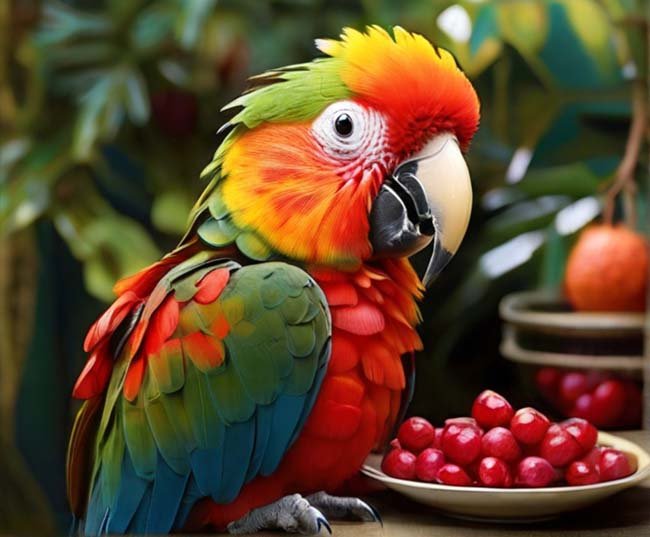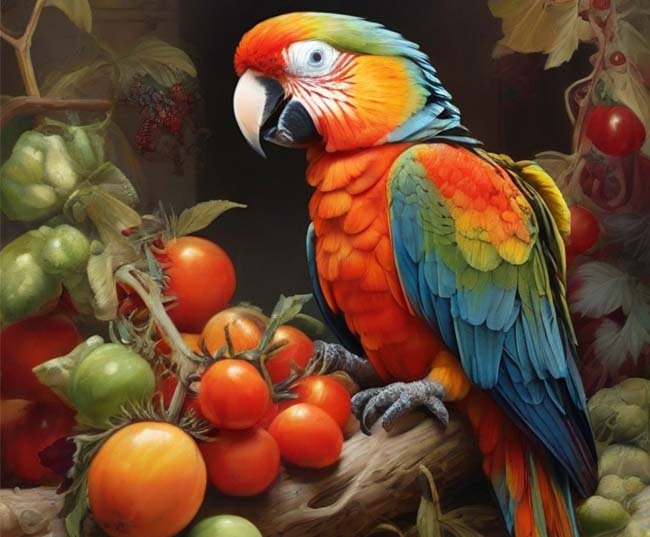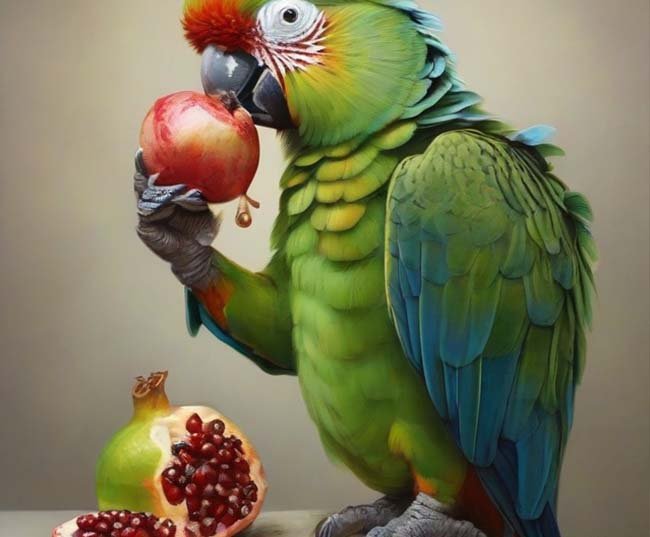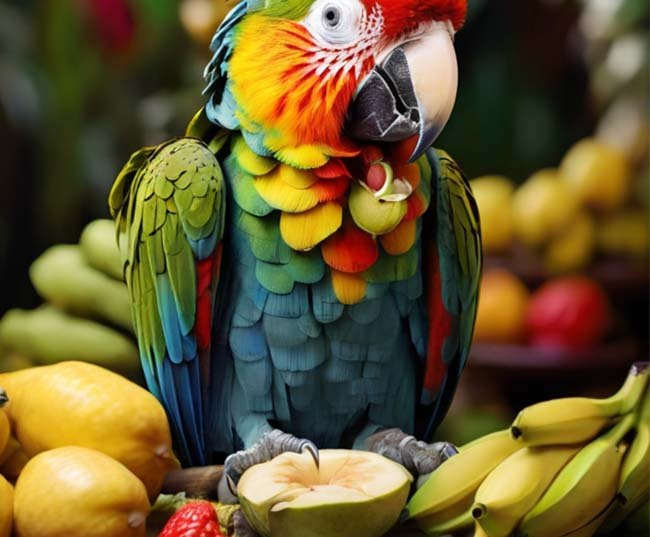Can Parrots Eat Cranberries? Step-by-Step Guide

Cranberries are a tart, bright red fruit popular around the holidays, often sauced up or baked into various dishes.
But can our feathered friends also enjoy this festive food? As with any human food introduced into a parrot’s diet, there are important considerations regarding nutritional content, preparation, and potential risks.
This complete guide dives into all facets regarding feeding cranberries to parrots.
So without any further, let’s dive into it.
Key takeaways:
- Parrots can eat cranberries in moderation, but they should not become a diet staple. Just 1-2 bite-sized pieces a couple of times a week is recommended.
- Fresh, raw whole cranberries are best. Avoid processed versions with added sugar or preservatives.
- Cranberries provide some beneficial nutrients like Vitamin C and antioxidants but have relatively low nutritional value compared to other fruits/veggies.
- Potential benefits include supporting immune and heart health. Risks mainly involve digestive irritation if over-fed.
- Start with very small amounts – a piece or two at a time. Monitor consumption and droppings closely for signs of issues.
- The majority of a parrot’s diet should still consist of a quality seed mix/pellets plus a variety of other vegetables and fruits, based on vet recommendations.
- Consult an avian vet regularly when making any dietary changes or additions. They can advise on appropriate foods and quantities tailored to the individual parrot.
- Immediately stop feeding cranberries and contact the vet if you observe any concerning changes in behavior, appearance, or excrement after serving the berries.
- Alternative fruits and vegetables that are more nutrient-dense and safer diet mainstays include items like blueberries, squash, peppers, sweet potato, etc.
Can Parrots Eat Cranberries? Explained
The quick answer is yes, parrots can eat cranberries, but only in moderation.
As with any new addition to a parrot’s menu, start slowly by trying just a taste first to observe any potential adverse effects before offering more.
The bulk of a parrot’s balanced diet should be comprised of a quality seed mix and pellet formulated specifically for their species and supplemented with bird-safe fruits and vegetables.
1). Nutritional Value of Cranberries for Parrots
Cranberries can provide some beneficial nutrients for parrots, though their nutritional value is relatively low compared to higher fiber options with additional vitamins and minerals.
The red hue of cranberries comes from flavonoids, which do have antioxidant properties that support overall health.
They also contain:
- Vitamin C
- Vitamin E
- Vitamin K1
One concern though is their very tart, acidic nature, so portion control is key.
2). Are Cranberries Safe or Toxic for Parrots?
In their raw, fresh, whole form – cranberries are generally safe for parrots. But there are some considerations and risks to keep in mind before freely feeding them:
- Dried cranberries or cranberry juice often have added sugar, which can be unhealthy.
- The tartness may irritate some sensitive parrot’s crops. It could cause digestive upset or even an overgrowth of yeast or bacteria for some birds.
So while not overtly toxic, their sharp flavor can cause problems if a parrot eats too many.
Moderating the quantity consumed is key along with keeping a close eye on droppings and behavior after feeding them.
3). Potential Benefits of Cranberries for Parrots
The nutrients mentioned previously – Vitamin C, E and antioxidants – are valuable for supporting a healthy immune system, skin, feathers, bones and overall wellness.
There is some evidence antioxidants can even help prevent certain cancers. Cranberries also have anti-inflammatory effects.
These benefits need to be kept in perspective though, as a balanced diet with plenty of varied fruits and vegetables will provide a wider, more complete spectrum of nutrients. Think of cranberries as more of a supplemental treat.
4). Potential Risks of Feeding Cranberries to Parrots
By only feeding fresh, raw whole cranberries sparingly, risks are quite minimal. But dangers can include:
- Digestive Irritation – Too much acidity can bother sensitive crops, the esophagus, stomach.
- Negative Food Associations – A bad experience after eating too many berries may cause a parrot to fear eating cranberries or trying new foods in the future.
- Aspiration hazard for juvenile parrots – Difficulty breaking down firmer chunks before swallowing.
- Interactions with medications – Unknown contraindications possible.
- Obesity if over-fed – Like any food, too many extra calories can cause weight gain and associated issues.
The key is refraining from over-feeding. Moderating the amount served prevents most issues.
Some parrots may tolerate more or less based on their sensitivities and preferences. Start slow when initially offering this treat.
5). How Much Cranberries Should Be Fed to Parrots
When first offering cranberries, limit the amount to just 1 or 2 bite-sized pieces per day – no more than 20 calories.
Observe eating behaviors and watch for any decrease in normal food consumption.
Adjust quantity fed up or down as needed based on observations over subsequent days.
For a 100-gram parrot, a general recommendation would be:
- Maximum of 8-10 average-size whole cranberries per week
- Given about 2 berries 2-3 days per week.
- Limit cranberry treats to once or twice weekly for most medium or larger parrots.
- Give one piece at a time over a full day.
The goal is to keep cranberries at around 5% or less of total food intake. Let the majority of diet come from balanced pellets, vegetables, grains and quality seed mix as directed by your avian vet.
6). Preparing and Serving Cranberries to Parrots
Most parrots enjoy investigating, playing with, and tasting fresh whole foods. The chewing action and exploratory play provide enrichment.
Here are preparation tips:
1). Rinse/scrub fresh cranberries under lukewarm water before serving to remove any dirt or residues. Pat dry.
2). Cut larger cranberries into smaller pieces if needed – Quartered or halved chunks for smaller birds.
3). Freeze dried cranberries are not advised, since the dehydrating process concentrates natural sugars to unacceptable levels. However, fully thawed frozen cranberries are fine in moderation.
4). Avoid adding any sweeteners, dressings, or additional ingredients – Stick to plain fresh berries. Too much sugar causes more harm than good.
5). Place berries into a small low bowl for the easiest access, rather than mixing them into the main food dish.
6). Start with just 1-2 pieces in a bowl, refilling later in the day if finished off. Or break servings across multiple feeding times.
7). Provide a mineral block for gnawing on which can help clean tart residue off the beak. Chewing serves as a natural palate cleanser.
8). Monitor consumption levels and transition to daily, every-other-day, or twice-weekly feedings based on observations and vet advice. The amount per serving depends on parrot size and tolerances.
8). Best Cranberry Products for Parrot Feeding
The optimal cranberry product for feeding most parrots would be plain, fresh or thawed frozen whole cranberries without any additives.
Read all food labels carefully. Many pre-packaged cranberry offerings have added sugars or preservatives that make them inappropriate to include in a parrot’s diet.
If opting to use more processed versions versus raw fresh berries, the best healthy alternatives would include:
- Frozen cranberries (let thaw before serving)
- Dried sweetened cranberries (a rare treat due to sugar content)
- All-natural cranberry sauce (LIMIT – high density still equals added sugar)
- 100% pressed cranberry juice (just a few drops diluted greatly with water)
9). Signs of Cranberry Toxicity in Parrots
Cranberries are not poisonous, but if moldy could grow dangerous fungi. Feeding them infrequently and properly stored greatly reduces the risk of contamination though.
Potential signs of cranberry-related trouble can include:
- Changes in droppings/urates – Color, consistency abnormalities
- Lethargy/listlessness
- Feather plucking
- Weight loss or gain
- Swelling near throat/crop region
- Changes in food consumption
- Reluctance to eat
- Difficulty breathing
If any distress signals or drastic behavioral shifts occur after feeding cranberries, immediately stop serving them and notify an avian vet right away.
Collect any regurgitated food samples for pathogenic testing if applicable. Keep the parrot calm and warm until the appointment.
10). Alternative Fruits and Veggies for Parrots
While cranberries can positively contribute to a balanced diet, they should not become a diet staple.
Parrots thrive best on a wide variety of fresh bird-safe options. Some more nutritious alternatives to offer rotationally include:
- Fruits – Raspberries, blueberries, apples, oranges, papaya, melon, banana, mango, pomegranate
- Vegetables – Carrots, sweet potato, peppers, green beans, squash, beets, broccoli, parsley and other greens
11). Consulting an Avian Vet About Parrot Diets
Every parrot species has unique nutritional requirements. Meeting those needs while also paying attention to individual bird’s preferences and sensitivities is important yet challenging.
Avian vets can assess a parrot’s health status and recommend customized diet plans accordingly, including appropriate treats.
Schedule regular well-bird checkups to discuss diet and get suggestions for new healthy food items to try.
Vets can analyze blood work and watch for early indicators of trouble that may relate to dietary imbalances.
Over time, fine-tune food choices to best match each bird’s aging needs and monitor closely for negative changes.
Consulting frequently with qualified avian professionals sets up parrots for nutritious success through every life stage!
The Bottom Line
Cranberries likely won’t end up a regular component of most parrots’ diets, but as an occasional treat, they can add some beneficial nutrients and fun, sensory enrichment.
By feeding raw, fresh whole cranberries in strict moderation, avoiding added sugars/preservatives, and watching closely for individual bird reactions, the risk is low.
Take care though not to allow overconsumption, instead integrate judiciously into a sound overall diet guided by an avian vet’s care.
Then both you and your feathered friend can enjoy a touch of festive, scarlet-red berry goodness through the holidays and beyond!






